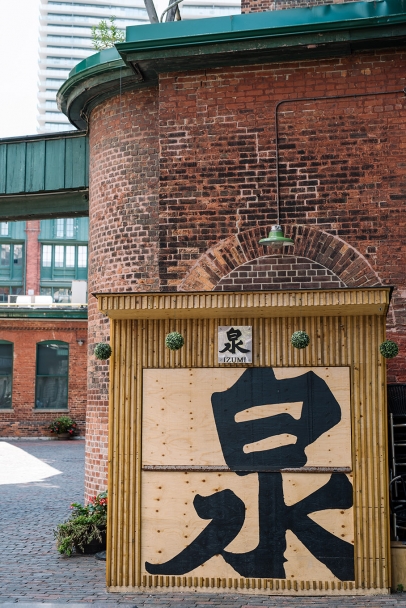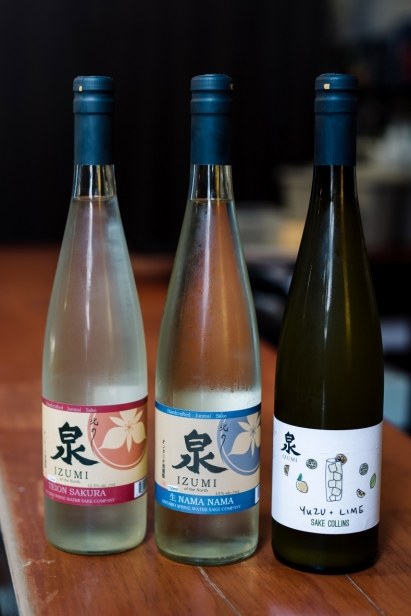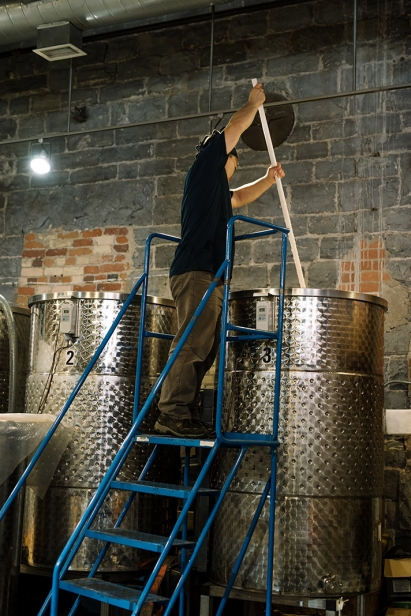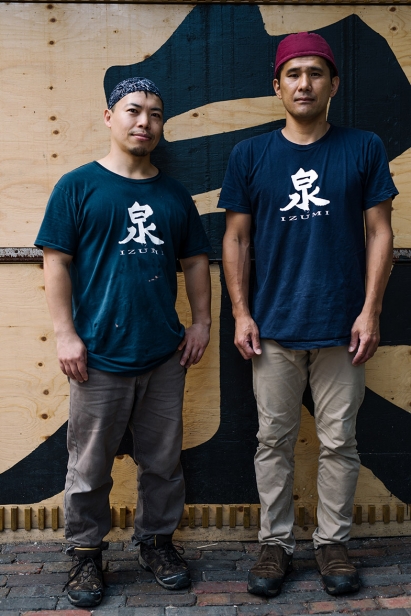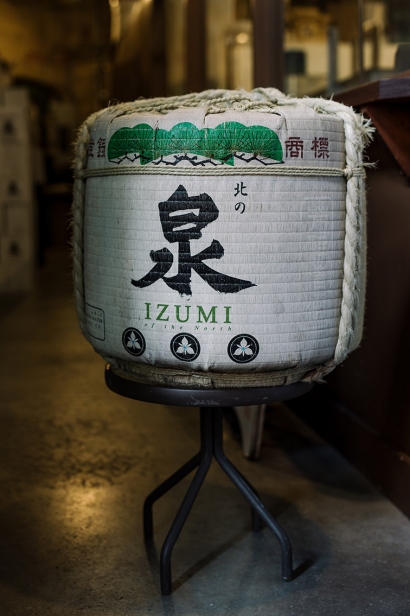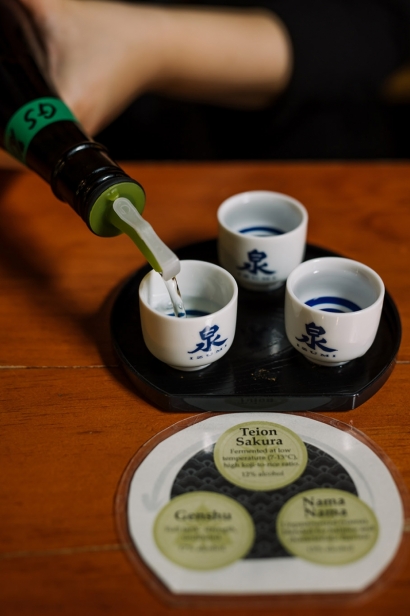A Unique Craft Brew
To see Ken Valvur, you’d never guess he’s a Japan-ophile. His sandy brown hair and Levi jeans betray his Toronto roots. But give him five minutes to share his love of the southeast Asian island nation, and you’ll understand how he became the baron of eastern North America’s first sake brewery.
The location for his Ontario Spring Water Sake Company oozes all the cool that comes with Toronto’s distillery district — and it also produces award-winning sake worthy of the most discerning palates.
Valvur’s journey from accountant and banker to sake magnate began when Scotiabank transferred him to Japan. It wasn’t long before he fell in love with everything about Tokyo, most of all the food and the sake. After his nearly five-year stint in Tokyo, he was transferred to London, where he noticed Japanese take-away was taking off. Soon after, he quit his banking job to move back to Toronto and open Bento Nouveau, a takeout sushi operation that grew exponentially and is now called Bento Sushi.
He was asked to sell majority control in 2007 and he did, only to eventually buy roughly the same percentage back when the opportunity arose in 2014. Today, Bento operates in 500 grocery stores and universities across Ontario and Quebec and also has standalone locations that sell its products.
It was when Valvur was temporarily free of Bento Sushi that he could pursue the idea of brewing sake in Toronto. His first move was to ask Japan’s Miyasaka Brewing Co. — a company he knew and admired — to serve as his consultants. Miyasaka, which brews sake under the brand, Masumi, agreed. They introduced him to a master sake brewer, Yoshiko Takahashi, who Valvur hired to come to Canada for one year. They also helped Valvur buy his equipment by offering up their suppliers. It was a good relationship because Valvur served as a Canadian importer of Masumi’s sake for a few years.
The man who’s now Valvur’s head brewer, Greg Newton, had worked in the same brewery as Takahashi. As a microbiologist, Newton had a good sense of brewing anyway. Takahashi trained him to become the head brewer and then they were ready to launch. Following the Japanese tradition, their sake — known by the brand name Izumi — has a different name from the brewery. Izumi means spring water, so it made sense as a name since they would be sourcing spring water from Ontario. Valvur also liked its Japanese character whose lower half means “water” and whose upper half means “white.”
“I think its shape is beautiful,” Valvur says of the character. “It’s also a Japanese girl’s name. I knew Canadians would be able to pronounce it because, when I was in Japan, I had a colleague by that name and all the Canadians could pronounce it.”
Today, the day-to-day operations of the brewery are run by a senior brewer, who works under the direction of the head brewer, and a sales manager, who runs the front-of-house operations, which includes selling a small number of items produced from sake’s biproducts. The brewery also offers tastings and cocktails at its small bar area.
The head brewer calls the shots on the brewery’s sake production. In all, an 11-member team runs the brewery. “It’s not a huge operation, so it’s fun,” Valvur says.
Nom nom, nama nama
It was unpasteurized sake — a raw, wilder version of the drink most of us know — that Valvur was determined to produce, in spite of its refrigeration requirement and shorter shelf life. He compares the taste difference to the difference between Tropicana orange juice and freshly squeezed orange juice. Unlike wine, youth can be a virtue for sake. Nama nama means it hasn’t undergone either of the two pasteurization steps sake brewers take to preserve shelf life. It’s this version that many sake connoisseurs prefer. It makes for a more fragile brew, Valvur says, “and like many things in Japan, it’s the fragility that makes it great.”
Almost everything he produces is unpasteurized, except for the version he sells to the LCBO and SAQ because their warehouses are unrefrigerated so the quality would deteriorate quickly. Valvur said pasteurization doesn’t alter the flavour too much, which is an advantage sake and beer have over wine. The latter are rarely pasteurized and therefore may require the addition of sulfites to preserve shelf life.
The art of sake brewing
Sake-brewing starts with rice and water — its two essential ingredients. The kind of water is important — it mustn’t have any iron or sulfur. Some sake brewers use hard water, with lots of calcium, potassium and magnesium, which makes a sake that is cleaner and generally higher in alcohol. Soft-water sakes, which have fewer of those elements, tend to be fruitier. Valvur’s is soft-water sake, a conscious choice because hard-water sake tends to be dryer. He figured the soft-water version would be more approachable for North Americans. He sampled water from nearby springs and ended up choosing a variety from Muskoka.
His rice, which originally comes from Japanese seeds, hails from California. The grade of sake is determined by how much of the outer portion of the rice grain has been milled away because the outer parts have more proteins and fats and the middle is closer to pure starch. For sake, the more milled it is, the better. Valvur has his rice milled down to 70 per cent of its original weight, which makes his a premium product, although not the highest grade.
Daiginjo is the highest grade of sake. It’s a super-premium product with the rice milled down by 50 per cent or more. Ginjo sake uses rice that’s been milled to between 60 and 50 per cent of its original weight.
Sakes in Japan vary in the rice used, with the king of sake rice being Yamada Nishiki, a short-grain variety that absorbs water well and dissolves easily.
“We’re very happy with the rice we’re using, but we’ll look at Yamada Nishiki every once in a while,” Valvur says, referring to the possibility of using the expensive variety for special-occasion batches.
Back to basics
The sake-making process starts by washing the rice to get rid of its powders. The Ontario Spring Water Sake Company began its brewing history by doing this manually, as it was taught by the Japanese master — also known as a toji — that they hired to consult, but it now uses a water-powered rice washer, which Valvur says doesn’t seem to compromise taste and is considerably less laborious.
Next, the rice — up to 100 kilograms at a time — goes into a steamer. You don’t want it as soft as you would for sushi, rather, think of the texture as al dente.
After it’s cooked, the rice must be cooled with industrial fans. Then, one quarter of it goes into the koji room — a type of fermentation room that is lined with cedar walls that boast antibacterial properties.
In this room, the brewers sprinkle the rice with a mould-spore called koji-kin and a yeast, both of which Valvur imports from Japan. The mould penetrates the rice and converts it into a sweet-smelling altered form called koji. Getting the proper yeast requires membership in the Japan Brewing Society because it owns the intellectual property on sake-brewing yeasts. Once the koji is finished curing — a three–day process — the brewers have everything they need to make sake.
With these products in hand, they add water to start a vigorous brew in a starter tank. After seven to 10 days, those contents go into a main tank. It takes four days to fill a tank plus 21 days of brewing after that before they can press the fresh sake. From start to finish, the process takes between 32 and 35 days.
Quality control
While the brew is in the tanks — tall, stainless steel contraptions that look like brewing tanks but are smaller, holding about 1,000 litres of liquid, and yielding between 550 and 600 litres of sake — the team takes samples and measures alcohol content, sugar content and acidity, watching those numbers as it ferments.
“We’re looking at the numbers and we’re smelling and tasting,” Valvur says. “Then, we pick the best day to press the sake. We can do that with precision because we’re small.”
From the tanks, they drain the mash and put it into pressing bags and then into the sake press — a machine that separates the rice from the fermented nectar. It comes out rapidly in the beginning and, as it approaches completion, it slows to a trickle. Whether a torrent or a trickle, the liquid is drinkable sake. It is now ready to bottle and sell to thirsty consumers.
Tradition matters
Before Valvur and his team started making sake, they had to present the brewing waters to the sake gods, which they did by way of a miniature shrine that sits on a perch, overlooking the operation.
"I think [the sake gods] were consuming it very judiciously because it was there for a long time,” Valvur says with a laugh.
To his surprise and delight, that first batch, which was finished in February 2011, tasted great. “
We opened our doors to the public the end of April 2012, after we’d made three batches in total,” he says.
Sake for sale
Today, with five years under their belts, they produce several varieties. The nama nama is the most popular and checks in at 15.5 per cent alcohol — about the same as an Amarone or super Tuscan red wine. It’s always served cold.
Nama cho is pasteurized once and it’s the principal product they sell to the LCBO. Because it’s therefore considered filtered, this one can be drunk warm or cold.
A darling of non-Japanese chefs, the teion sakura is made at a lower average temperature, which means the alcohol is lower and there’s therefore more acidity, with apple, pear or melon fruitiness.
“A lot of chefs who are doing non-Japanese food go for this one,” Valvur says. “For the Gold Medal Plates competition, George restaurant used this one and paired it with a black cod dish.”
When it comes to sweetness, sake’s rating method is the opposite of wine’s. Pluses are dry and minuses are sweeter. All of Izumi sakes tend to be close to zero.
Izumi’s coarse-filtered sake (so named because a portion of stillfermenting mash has been coarse-filtered into it at the last stage), known as Nigori, is good with meat, Valvur said. A cloudy brew, it’s his favourite, because he considers it “more real.”
In addition to these varieties of sake, Valvur produces two pre-made sake cocktails. The sake version of a Cosmopolitan has cranberry, lime, yuzu and sake, and the Yuzu Lime Sake Collins is the second. “People seem to like them because they’re lower in alcohol than the traditional versions of these cocktails,” Valvur says.
In addition to the straight sake, the brewing shop sells soap, kasu (a gluten-free flavour enhancer sought by many Japanese customers), salad dressing and ice cream — all of which are made from what’s left in the press when the liquid is removed. They’ve also sent their kasu to wagyu beef producers, including Ontario Wagyu in Formosa, Ont., to fatten up the cattle, and they’ve done the same with pork and lamb — mostly as marketing stunts with restaurants.
Ontario’s embrace
When he launched, he was met with a lot of skepticism from chefs in traditional Japanese restaurants, but Valvur said most of them have come around.
“We now fill small tanks for them so they can have it on tap,” he says. “They keep it in a refrigerator. Our biggest customers have switched over to draft sake.”
In the distillery district, his neighbours, which include ice cream shops and art galleries, were nervous about the smells the brewery might emit, but they too have come around because, as Valvur puts it: “Every stage smells delicious.”
He’s even entered into partnerships with a couple of Toronto businesses. Greg’s Ice Cream is the company that makes ice cream out of his koji — in flavours such as soy meal, black sesame and green tea — and Yongehurst Distillery used some of his koji to make shochu, a popular Japanese distilled liquor.
Still another nearby shop makes his kasu into soap, which he then sells in his brewery shop.
The future looks bright
To encourage sake awareness in Ontario, Valvur co-founded the Sake Institute of Ontario. The institute puts on a big festival known as Kampai Toronto each year and business continues to expand. Sales have grown by 15 per cent every year since he launched.
“It won’t continue forever, but sake’s growing at that level,” he said, and added that he considers the brewery a labour of love while Bento Sushi gives him his bread and butter. Nevertheless, Ontario Spring Water Sake Company pays all its bills and turns a profit.
“I don’t have to worry about this place,” he says. “I did it because I wanted a fun project. I like coming here and I like going to visit the restaurants that serve our sake. It’s a very fun business.”
Ontario Spring Water Sake Company
51 Gristmill Lane, Toronto, Ont.
ontariosake.co, 416.365.7253


